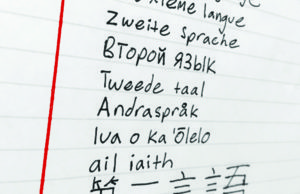Changes in curriculum aim to increase rigor of Iowa schools, better preparing students for future skills, global competition
By Kellie Petersen 2009
A new semester may have brought some changes to Cedar Falls High School, but education across the state of Iowa is poised to begin undergoing some big changes with the Iowa Core Curriculum.
The Iowa Core Curriculum, formally known as the Model Core Curriculum, became official after being passed by the Iowa legislature on April 25, 2008, which was the last day of the legislative session for that year. The Iowa Core Curriculum was then signed by Gov. Chet Culver on May 1 in Independence.
“Well, the Core Curriculum is kind of revolutionary for Iowa,” English teacher Jennifer Paulsen said regarding what she thought of the new guidelines.Paulsen teaches the reading enhancement class, which aims to provide students with developing improved fluency in reading, vocabulary development, comprehension and independent reading skills.
As a teacher of this specific class, Paulsen can provide some insight into the Iowa Core Curriculum, since classes like reading enhancement contain similar objectives for improvement.
“It’s definitely going to reinforce this class. The class is designed to build strategic readers and the state is now establishing reading curriculum at the secondary level,” Paulsen said.
According to the Iowa Department of Education website, the Iowa Core Curriculum will provide “a guide to delivering instructional content that is challenging and meaningful to students.” The Iowa Core Curriculum aims to provide this content in five main areas of literacy, mathematics, science, social studies and 21st century skills, which include civic literacy, financial literacy, technology literacy, health literacy and employability.
Dan Conrad, the Director of Secondary Education for Cedar Falls schools, said that the new Iowa Core Curriculum would require a “reshaping of our K-12 curriculum.”
“There will be some things included in English, math, science or social studies that we may not already be including in our 7th grade, 6th grade, 4th grade, 3rd grade curriculum,” Conrad said.
Conrad elaborated on how the Iowa Core Curriculum may change Cedar Falls, as well as other, schools.
“Ultimately, we will probably need to revise graduation requirements to meet the Iowa Core. Over the next couple of years, we will be reviewing and learning more about the Core and the gaps in what we are currently requiring all students to demonstrate and what will be required when the Core is implemented,” Conrad said.
Conrad said that the Cedar Falls School District would need to re-examine the “structure” of its schools, including schedule and course requirements, in order to make revisions that will meet the Iowa Core Curriculum.
Although the Iowa Core Curriculum may ask some school districts to make changes to what they teach, it is all a part of a larger goal to better prepare students for life after school by providing a more rigorous and relevant education. Judy Jeffery, Director of the Iowa Department of Education, described the Iowa Core Curriculum as providing the “essential concepts and skills” necessary for students to achieve a more rigorous and relevant education.
Rigor and relevance may seem like familiar phrases to any student in Iowa, and they are an important part of the Iowa Core Curriculum.
William Callahan, the Dean of the College of Education at the University of Northern Iowa, helped develop the Iowa Core Curriculum as a member of the Leadership Team. “Rigor means that it challenges the students and delves deep into content setting high expectations for student performance. Relevant means that the activities are relevant to the content and to real life,” Callahan said.
The concepts of rigor and relevance are one way that Cedar Falls Schools have utilized concepts of the Iowa Core Curriculum prior to its implementation.
“For the past three years, the high school and both junior high schools have been working with the Department of Education and AEA267 on the Rigor, Relevance, Relationships Framework. Especially at the high school, this has been a major focus of our professional development for teachers,” Conrad said.
Although the concepts of rigor and relevance are important to the Iowa Core Curriculum, they are certainly not the only key components. The addition of what are being called 21st century skills, or literacy in the areas of civics, health, financial situations and technology as well as employability skills, are also very important to the Iowa Core Curriculum.
Jeffery explained why the addition of 21st century skills were made to the Iowa Core Curriculum, citing that it was noticeable that students were not as prepared as they could be in these important areas.
“Whenever we have those high concerns, schools need to take a good look at what they’re teaching and how they’re teaching,” Jeffery said.
In addition to giving students more of a foundation in 21st century skills, the Iowa Core Curriculum also aims to help students in Iowa compete better on a global scale. The ability of Iowa’s and America’s students to be on the same educational level as students in other countries is an issue that has become increasingly important.
“It’s really happening across the nation. States are really taking a look at what students need to compete in a global way,” Jeffery said of the initiative to better prepare both Iowan and American students to compete with their foreign counterparts.
Regarding global competition, Callahan also noted that as of now there is no way the United States could compete with a country like China.
“The future workers have to be smart, creative and well-educated,” Callahan said.
Whether or not it is working to create students and future workers that are better able to compete on a global scale, the Iowa Core Curriculum aims to help students better prepare for their futures, whatever they may hold.
Not only does the Iowa Core Curriculum benefit students by preparing them for their futures and helping them to compete with students in foreign countries, but it also benefits teachers by creating more clear, concise and uniform educational standards.
“What this is going to do is equalize teaching across the state,” state senator Brian Schoenjahn said.
As a former teacher he said he would welcome the Iowa Core Curriculum.
Although many praise the Iowa Core Curriculum, it is not without its share of opposition.
“Any education research you’re going to have people on both sides,” Conrad said.
Among the criticisms for the Iowa Core Curriculum are that it does not provide rigorous enough standards and was not supported strongly enough by experts.
State senator Paul McKinley has been an outspoken opponent of the Iowa Core Curriculum for these two reasons.
“What we need to be dealing with is rigorous standards. This is curriculum and what is needed is world-class standards,” McKinley said.
McKinley cited examples of other states, specifically Massachusetts, that had the types of standards he believed would have been more of a benefit to Iowa students. He said that
many educational experts acknowledge the Massachusetts standards as the best.
“Their students perform at a very high level and that’s what we should aspire to,” McKinley said.
Another aspect of the Iowa Core Curriculum that McKinley disagrees with is its support and approval by educational experts.
“We had it independently reviewed, and it came up short, “ said McKinley of the Iowa Core Curriculum.
Another topic of concern that has gained the attention of many people in addition to McKinley is the influence of the educational consultant Willard Daggett on the Iowa Core Curriculum. Many of Daggett’s concepts and examples he uses to back up these concepts have been publicly criticized.
“The curriculum is based on a faulty theory of learning in my opinion and many others,” McKinley said.
However, the influence of Daggett on the Iowa Curriculum and the effect his influence had remains an issue of disagreement. Callahan explained how much Daggett actually influenced the Iowa Core Curriculum, specifically through the concepts of rigor and relevance.
“Many of Daggett’s concepts were reviewed, but many were not included, this one was. This sort of thinking had a lot of influence into what we wanted the Iowa Core Curriculum to do, so in that sense Daggett had a lot of influence, but the way in which things were done was not how Daggett would have done it,” Callahan said of the concepts of rigor and relevance.
In spite of how little Daggett may have actually influenced the Iowa Core Curriculum, its effectiveness remains a divided issue.
“Our kids are better than that. They deserve better,” McKinley said of the Iowa Core Curriculum.
Although there may be some disagreement over the Iowa Core Curriculum, the reality is that with its passage by the Iowa legislature it will become a state mandated educational policy.
Currently, the Iowa Core Curriculum is set for full implementation in grades nine-12 by 2012 and grades kindergarten-eight by 2014. However, individual school districts will be allowed plenty of time to implement the changes brought about by the Iowa Core Curriculum, as well as flexibility in how they chose to implement changes.
“The state gave the school districts time to adjust to this new core,” Jeffery said.
Conrad also acknowledged that with an implementation deadline of 2012 Cedar Falls would have time for planning.
Jeffery described how the Iowa Core Curriculum would implement changes without creating strict requirements as to how the changes should be implemented by individual school districts.
“It’s more of an explanation of what students need to have in order to obtain state standards,” Jeffery said.








You must be logged in to post a comment Login